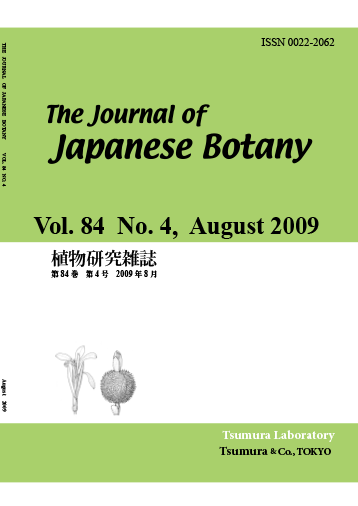
- Issue 6 Pages 321-
- Issue 5 Pages 263-
- Issue 4 Pages 197-
- Issue 3 Pages 131-
- Issue 2 Pages 063-
- Issue 1 Pages 001-
- |<
- <
- 1
- >
- >|
-
Article type: cover
2009Volume 84Issue 4 Article ID: 84_4_10143
Published: August 20, 2009
Released on J-STAGE: October 20, 2022
JOURNAL FREE ACCESSDownload PDF (297K) -
Hiroyoshi Ohashi, Tomoyuki Nemoto, Kazuaki OhashiArticle type: Originals
2009Volume 84Issue 4 Pages 197-223
Published: August 20, 2009
Released on J-STAGE: October 20, 2022
JOURNAL FREE ACCESSChinese members of subgenus Macrolespedeza in the genus Lespedeza are revised.Eight species are recognized in China. A key to the species, bibliography of the species,and synonyms are provided. Lespedeza dunnii Schindl. and L. fordii Schindl. are newly accommodated in the section Heteroloespedeza. Lespedeza thunbergii is divided into newly circumscribed subsp. thunbergii, subsp. formosa (Vogel) H. Ohashi and subsp. elliptica (Benth. ex Maxim.) H. Ohashi (comb. nov.). Lespedeza formosa (Vog.) Koehne, L. patens Nakai, L. pubescens Hayata, L. viatorum Champ. ex Benth., and L. wilfordii Ricker in Flora Reipublicae Popularis Sinicae (FRPS) vol. 41 (1995) are regarded as synonyms with L. thunbergii (DC.) Nakai. Of the unknown species in FRPS L. hupehensis Ricker and L. merrillii Ricker are considered as synonyms of L. davidii and L. veitchii Ricker as a synonym of L. bicolor.
View full abstractDownload PDF (6896K) -
Nobuko Yamamoto, Okihito Yano, Hiroshi IkedaArticle type: Originals
2009Volume 84Issue 4 Pages 224-228
Published: August 20, 2009
Released on J-STAGE: October 20, 2022
JOURNAL FREE ACCESSA putative hybrid between Crepidiastrum denticulatum (Houtt.) J. H. Pak & Kawano and C. yoshinoi (Makino) J. H. Pak & Kawano, Crepidiastrum xsemiauriculatum N. Yamam. & H. Ikeda (Asteraceae: Lactuceae), is described from a limestone area in Okayama Prefecture, western Japan. This plant differs from the presumed parents by the semi-auriculate base of the inflorescence bracts (deeply auriculate in C. denticulatum and attenuate in C. yoshinoi), and intermediate state of several characters of the flowers and fruits: florets 6-8 per capitulum (11-15 in C. denticulatum and 5 in C. yoshinoi), ligules 8.5-9.0 mm long (7.8-8.3 mm in C. denticulatum and 9.0-9.3 mm in C. yoshinoi), and achenes 3.8-4.3 mm long (3.2-3.8 mm in C. denticulatum and 4.5-5.0 mm in C. yoshinoi).
View full abstractDownload PDF (661K) -
T. K. PaulArticle type: Originals
2009Volume 84Issue 4 Pages 229-232
Published: August 20, 2009
Released on J-STAGE: October 20, 2022
JOURNAL FREE ACCESSSaurauia nicobarica T. K. Paul is described from Great Nicobar Islands as new to science. This species is characterized by its leaves having an acute or obtuse base, bracts linear lanceolate, densely hairy, outer two sepals densely brown tomentose and sparsely pilose fruits.
View full abstractDownload PDF (523K) -
Vinay Ranjan, S. C. SrivastavaArticle type: Originals
2009Volume 84Issue 4 Pages 233-236
Published: August 20, 2009
Released on J-STAGE: October 20, 2022
JOURNAL FREE ACCESSSaurauia parasnathensis V. Ranjan & S. C. Srivastava is described from India as new to science. This species is characterized by having cymose inflorescence with manyflowered fascicles, yellow flowers and 27-35 stamens in two rows.
View full abstractDownload PDF (640K) -
Hideaki Ohba, Shinobu Akiyama, Gerard ThijsseArticle type: Originals
2009Volume 84Issue 4 Pages 237-254
Published: August 20, 2009
Released on J-STAGE: October 20, 2022
JOURNAL FREE ACCESSIn 1851, Carl Lodewijk von Blume, who studied extensively the specimens collected in Japan by Siebold, Bürger, their successors, and their Japanese correspondents, described a great number of new species and varieties of Quercus and other genera of Fagaceae. His treatment, especially of Quercus, influenced later workers on the family, and also studies of the flora and vegetation of Japan. To stabilize the taxonomy of the family, lectotypes for taxa described by Blume are herein designated for Quercus (13 species and 13 varieties), Lithocarpus (1 and 2), Castanea (1 and 10), and Fagus (1 and 2).
View full abstractDownload PDF (1066K) -
Hiroyuki Kashiwadani, Keisuke Kobayashi, Kwang Hee MoonArticle type: Originals
2009Volume 84Issue 4 Pages 255-258
Published: August 20, 2009
Released on J-STAGE: October 20, 2022
JOURNAL FREE ACCESSLepraria ohmiensis Kashiw., Keis. Kobay. & K. H. Moon is described from Prov. Ohmi (Shiga Pref.), central Japan. It is easily distinguished from allied species of Lepraria in having a thick thallus and in producing lecanoric acid and pannaric acid esters as major chemical substances. Protoblastenia rupestris (Scop.) Steiner is newly reported for Japan. A new locality of Dictyocatenulata alba Finley & E. F. Morris in Japan is reported.
View full abstractDownload PDF (446K) -
Hiroo KanaiArticle type: Notes
2009Volume 84Issue 4 Pages 259-260
Published: August 20, 2009
Released on J-STAGE: October 20, 2022
JOURNAL FREE ACCESSRoman spelling of Japanese plant name represents its pronounciation and does not always represent its Kana-moji spelling as shown in Table 1.
View full abstractDownload PDF (389K) -
[in Japanese]Article type: Book review
2009Volume 84Issue 4 Pages 261
Published: August 20, 2009
Released on J-STAGE: October 20, 2022
JOURNAL FREE ACCESSDownload PDF (309K) -
[in Japanese]Article type: Book review
2009Volume 84Issue 4 Pages 261-262
Published: August 20, 2009
Released on J-STAGE: October 20, 2022
JOURNAL FREE ACCESSDownload PDF (596K) -
[in Japanese]Article type: Book review
2009Volume 84Issue 4 Pages 262
Published: August 20, 2009
Released on J-STAGE: October 20, 2022
JOURNAL FREE ACCESSDownload PDF (333K)
- |<
- <
- 1
- >
- >|